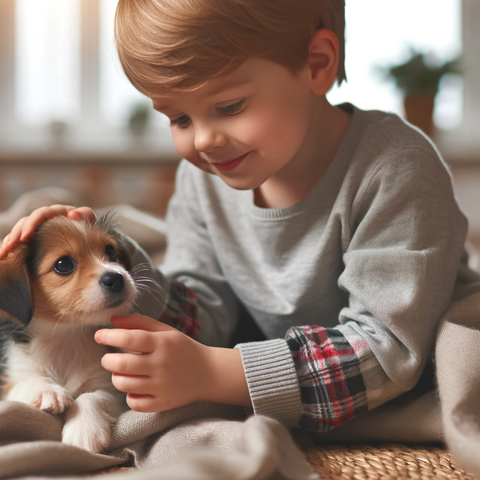






Choosing a Pet for Children
Choosing a Pet for Children
Choosing a pet is a particularly important decision for families with young children. This decision impacts not only the family's lifestyle but also the development of the children and their understanding of responsibility and caring for others.
Factors to Consider When Choosing a Pet

- Children's age and level of responsibility - Choose a pet that matches the children's ability to care for it.
- Size and type of the pet - Each pet has different needs and requirements, it's important to choose a pet that fits your living space and lifestyle.
- Level of activity and maintenance required by the pet - Consider the time and resources needed to care for the pet.
- Possible allergies in the family - Check if any family members have sensitivities to hair or specific animals.
Choosing a Pet Based on the Children's Age
Children of different ages cope with pets in various ways. Younger children have less ability to care for a pet independently, so it's important to choose a pet that doesn't require complex daily care or special treatment.
Dog and Cat Breeds Suitable for Children
There are many breeds of dogs and cats that are particularly suitable for families with children, thanks to their friendly and patient nature. Among dog breeds, Labrador Retrievers and Golden Retrievers excel in their loving and playful nature, which is especially suitable for playing with children. Other breeds such as Beagles and Poodles are characterized by a pleasant and sociable nature, making them perfect for young families.
In the realm of cats, breeds such as Ragdolls and Maine Coons are known for their calm and sociable nature. Ragdolls, for example, are known for their patience and love of cuddling, making them suitable for families with children. Maine Coons, with their long and impressive fur, are also known for their friendly and loving nature, and are well suited for homes with children looking for a brave and sociable playmate.
Additional Aspects in Choosing a Pet
In addition to these factors, it's important to consider the financial costs involved in purchasing and caring for a pet, including food, medical treatments, and accessories. Also, consider the time required to care for the pet and the emotional investment required.
Impact of Pets on Child Development

Pets provide deep emotional support to children and serve as a source for learning important values such as compassion, love, and patience. The bond formed between children and their pets allows children to experience unconditional love and learn about the importance of emotional connection with other beings.
Beyond that, pets encourage the development of a sense of responsibility in children. When children learn to care for a pet, they deal with daily concerns such as feeding, bathing, and walking, which teaches them about commitment and caring for the needs of another creature. Pets can also help children develop social skills and improve their ability to cope with feelings of disappointment or fear.
The special bond formed between children and their pets also impacts the children's self-confidence. The sense of responsibility developed by the children and the daily interaction with the pet helps them feel more confident in their ability to care and be responsible for another living creature.
Comparison Table: Types of Pets and Their Characteristics
Importance of Parental Involvement
Parental involvement in the process of choosing a pet and caring for it after it comes home is especially important. Parents need to be involved in educating the children on how to care for the pet and ensure its health and well-being.
Long-Term Commitment
Choosing a pet is a long-term commitment that requires time, effort, and resources. It's important to understand that caring for a pet is not just a temporary activity but a commitment for the entire life of the pet.
Tips for Maintaining the Health of the Pet
Maintaining the health of the pet is very important. This includes periodic medical care, balanced nutrition, regular exercise, and caring for its mental and physical well-being.
Educational Aspects of Pets
Pets contribute to the educational and emotional development of children, teaching values such as love, compassion, and responsibility. Children learn to care for a living creature and understand the importance of commitment and responsibility towards it.
Family and Pet: Relationships and Interactions
Creating good relationships between family members and the pet is an important component of family life. It's important to encourage positive and respectful interactions with the pet and ensure that it integrates harmoniously into family life.
Additional Information and Resources
For more information and resources on pets for children, it's recommended to search professional websites, forums on the subject, and consult with experts in the field.

Frequently Asked Questions
- What are the best breeds of dogs and cats for families with children?
Breeds of dogs such as Labrador Retrievers, Golden Retrievers, and Poodles are considered suitable for children. In cats, breeds such as Siamese and Maine Coons are considered sociable and loving.
- How can children be prepared for the arrival of a new pet in the house?
It's important to talk to the children about the responsibility of caring for a pet, to explain to them what needs to be done, and to demonstrate proper care of the pet.
- What are the best ways to teach children about responsibility for a pet?
Hands-on training, such as teaching the children to feed the pet, take care of it, and play with it, as well as participating with them in pet care activities.
- Are dogs suitable for all types of homes?
It depends on the breed. Larger dogs require more space and physical activity, while smaller dogs can be suitable for an apartment.
- Which dog breeds are the best for children?
Breeds like Labrador Retrievers, Beagles, and Poodles are considered friendly and suitable for families with children.
- Are there pets that are not suitable for children with allergies?
Yes, there are pets that can cause allergic reactions, such as cats with long fur or certain dog breeds. It's important to choose pets known to be hypoallergenic or check for hypoallergenic options.
Summary
Choosing a pet for a family with children is a complex process that requires thoughtful consideration of the needs of all family members. By taking all the above factors into account, you can choose the most suitable pet for your family, ensuring a loving and supportive environment for everyone.
